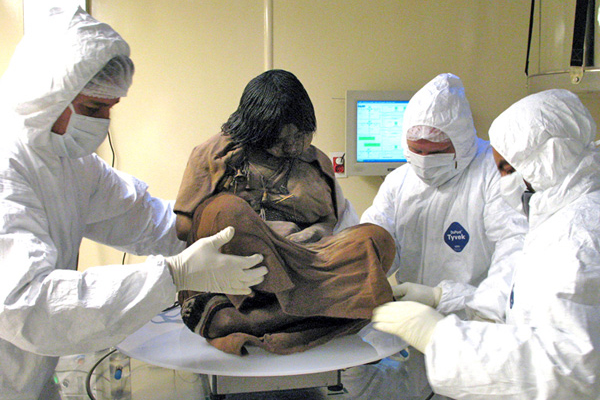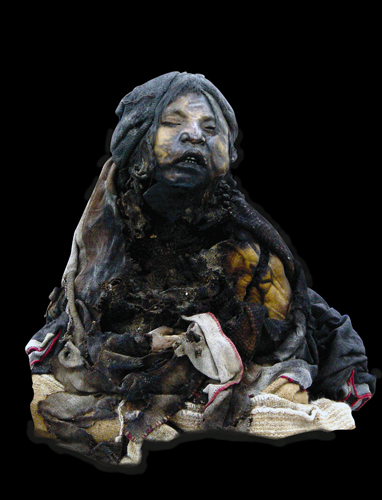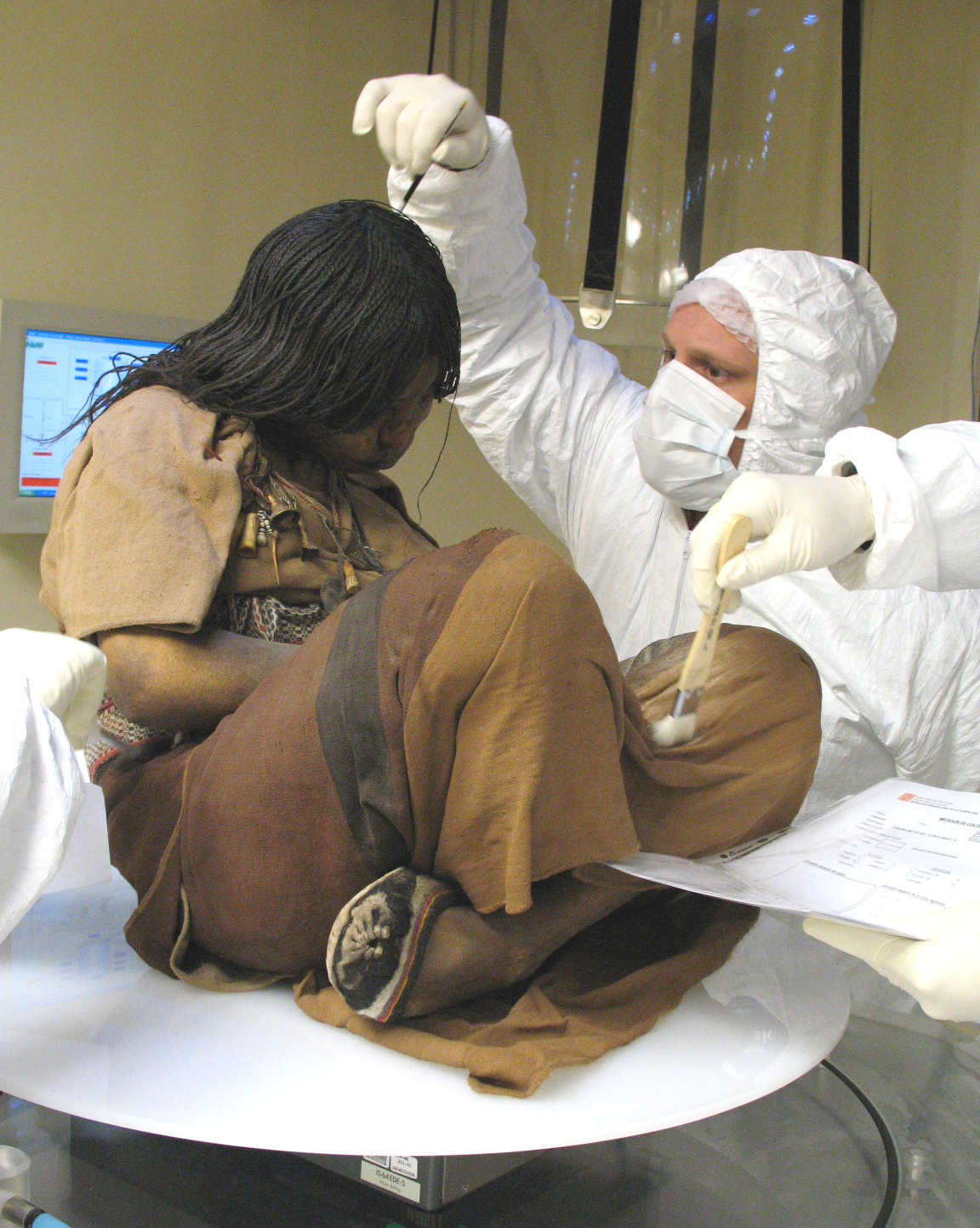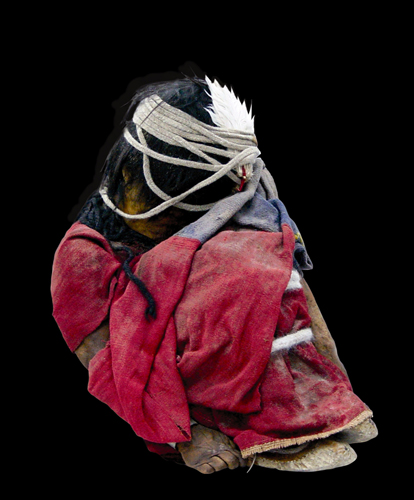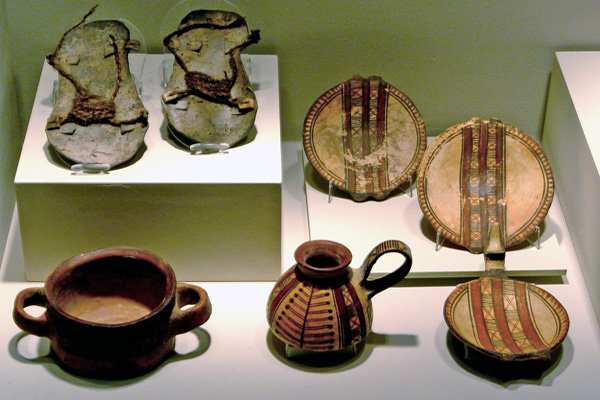Evidence that Incas Fattened up their Children Before Sacrificing Them
posted on July 28th, 2008 in Andes Mountains, Archaeology, Incas, Peru, Peruvian Mummies, Recent Discoveries
(Above: Scientists examine a 15-year-old girl who lived in the Inca Empire, then was sacrificed and remained frozen for 500 years)
Incas fattened up their children before sacrifice on the volcano
The Times
October 2, 2007
Grim evidence of how the Incas “fattened up” children before sacrificing them to their gods has emerged from a new analysis of hair from two 500-year-old mummies preserved near the summit of a volcano…
The remains of the 15-year-old girl known as the “Llullaillaco Maiden” and the seven-year-old “Llullaillaco Boy” revealed that their diets changed markedly in the 12 months up to their deaths, shedding new light on the rituals of the ancient Andean civilization.
The research, by a British-led team, suggests that the children were fed a ceremonial diet before being marched to a shrine 82ft (25 metres) from the top of the 22,110ft (6,739 metres) volcano Llullaillaco, where they were suffocated or left to die from exposure.
Before being chosen as sacrificial victims, the boy and girl had followed a typical peasant diet. This raises the possibility that they were chosen from among the Incas’ conquered subjects and killed not only to pacify the mountain gods, but also to instill terror and respect for an imperial power. “It looks to us as though the children were led up to the summit shrine in the culmination of a year-long rite, drugged and then left to succumb to exposure,” said Timothy Taylor of the University of Bradford, one of the lead researchers.
“Although some may wish to view these grim deaths within the context of indigenous belief systems, we should not forget that the Inca were imperialists too and the treatment of such peasant children may have served to instill fear and facilitate social control over remote mountain areas.”
The two mummified bodies, along with a third belonging to a six-year-old girl, were discovered in 1999 on Llullaillaco, in northwestern Argentina, near the Chilean border.
All are exquisitely preserved, though the younger girl’s body had been damaged by a lightning strike, giving her the nickname “Lightning Girl”. The Maiden of Llullaillaco or “La Doncella”, which is considered among the best preserved of all Andean mummies, has gone on public display recently for the first time, at the High Mountain Archaeological Museum in the nearby town of Salta.
“Lightning Girl” was a six-year-old girl who the Incas sacrificed and was later struck by lightning
In the new research, Dr Taylor, his colleague Andrew Wilson and others have now examined hair taken from the Maiden and the Boy for isotopes of carbon, nitrogen, oxygen and hydrogen. Isotopes are atomic variants of particular elements, and their relative abundance in hair, can reveal detailed information about an individual’s diet and where he or she once lived.
The study, which is published in the journal Proceedings of the National Academy of Sciences, shows that the children spent much of their lives eating a diet composed primarily of vegetables, such as potatoes, which indicates a peasant background.
In the 12 months before their deaths, however, both children’s hair shows that they started to receive maize, which was considered a food of the elite, and animal protein, almost certainly from dried llama meat known as charki.
“By examining hair samples from these unfortunate children, a chilling story has started to emerge of how the children were ‘fattened up’ for sacrifice,” Dr Wilson said.
“Given the surprising change in their diets and the symbolic cutting of their hair, it appears that various events were staged in which the status of the children was raised. In effect, their countdown to sacrifice had begun some considerable time prior to death.”
The hair isotopes show a further change in the children’s lifestyle about three to four months before they died, which suggests that is when they began their pilgrimage to the volcano, probably from the Inca capital, Cuzco.
It is thought that the children were given maize beer or chicha and coca leaves, both to alleviate the symptoms of altitude sickness and to drug them into compliance with their fates. Byproducts of coca metabolism have been found in the hair of the children, with particularly high concentrations in the Maiden’s. As the oldest, she may have had more idea about what was about to happen to her.
It is known that the Incas who conquered the indigenous tribes of the Andes chose the sons and daughters of local rulers and particularly attractive children for sacrifice. Some girls, known as acllas, were chosen at the age of around 4 and raised by priestesses. Some would be offered as wives to local nobles, others would become priestesses and others would later be sacrificed.
The two girls appear to have been left to die from exposure – at such a high altitude, it would not have taken long for children to die. Previous research, however, has shown that the Boy was suffocated by having a textile wrap drawn so tightly around him that his ribs were crushed and his pelvis dislocated.
Empire of the Sun
— The Inca empire began in the Cuzco region of the highlands of Peru in the early 13th century
— During the next two centuries the empire grew to dominate the Andes, including large parts of modern Ecuador, Peru, Bolivia, northwest Argentina, northern Chile and southern Colombia
— It survived until the 16th century, when the Spaniards arrived under Francisco Pizarro in 1532. The following year Atahualpa, the Inca Emperor, was murdered and Spanish rule established
— Inca religion was centered on the Sun god Inti, but the empire tolerated the many local gods or huacas venerated by subjects
— Though not as bloodthirsty as the Aztecs of Mexico, the Incas indulged in human sacrifice, particularly of children, in a ceremony known as capacocha
Some of the Inca burial objects found alongside the sacrificed Llullaillaco children

